
Quantum computing offers the promise of solutions to previously unsolvable problems, but in order to deliver on this promise, it will be necessary to preserve and manipulate information that is contained in the most delicate of resources: highly entangled quantum states. One thing that makes this so challenging is that quantum devices must be ensconced in an extreme environment in order to preserve quantum information, but signals must be sent to each qubit in order to manipulate this information—requiring, in essence, an information superhighway into this extreme environment. Both of these problems must, moreover, be solved at a scale far beyond that of present-day quantum device technology.
Microsoft’s David Reilly, leading a team of Microsoft and University of Sydney researchers, has developed a novel approach to the latter problem. Rather than employing a rack of room-temperature electronics to generate voltage pulses to control qubits in a special-purpose refrigerator whose base temperature is 20 times colder than interstellar space, they invented a control chip, dubbed Gooseberry, that sits next to the quantum device and operates in the extreme conditions prevalent at the base of the fridge. They’ve also developed a general-purpose cryo-compute core that operates at the slightly warmer temperatures comparable to that of interstellar space, which can be achieved by immersion in liquid Helium. This core performs the classical computations needed to determine the instructions that are sent to Gooseberry which, in turn, feeds voltage pulses to the qubits. These novel classical computing technologies solve the I/O nightmares associated with controlling thousands of qubits.
Quantum computing could impact chemistry, cryptography, and many more fields in game-changing ways. The building blocks of quantum computers are not just zeroes and ones but superpositions of zeroes and ones. These foundational units of quantum computation are known as qubits (short for quantum bits). Combining qubits into complex devices and manipulating them can open the door to solutions that would take lifetimes for even the most powerful classical computers.
Microsoft research podcast
Collaborators: Silica in space with Richard Black and Dexter Greene
College freshman Dexter Greene and Microsoft research manager Richard Black discuss how technology that stores data in glass is supporting students as they expand earlier efforts to communicate what it means to be human to extraterrestrials.
Despite the unmatched potential computing power of qubits, they have an Achilles’ heel: great instability. Since quantum states are easily disturbed by the environment, researchers must go to extraordinary lengths to protect them. This involves cooling them nearly down to absolute zero temperature and isolating them from outside disruptions, like electrical noise. Hence, it is necessary to develop a full system, made up of many components, that maintains a regulated, stable environment. But all of this must be accomplished while enabling communication with the qubits. Until now, this has necessitated a bird’s nest-like tangle of cables, which could work for limited numbers of qubits (and, perhaps, even at an “intermediate scale”) but not for large-scale quantum computers.
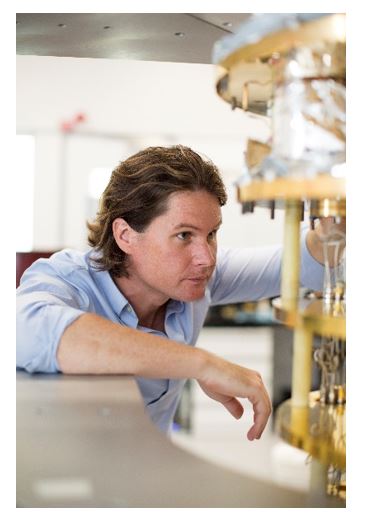
Microsoft Quantum researchers are playing the long game, using a wholistic approach to aim for quantum computers at the larger scale needed for applications with real impact. Aiming for this bigger goal takes time, forethought, and a commitment to looking toward the future. In that context, the challenge of controlling large numbers of qubits looms large, even though quantum computing devices with thousands of qubits are still years in the future.
Enter the team of Microsoft and University of Sydney researchers, headed by Dr. David Reilly, who have developed a cryogenic quantum control platform that uses specialized CMOS circuits to take digital inputs and generate many parallel qubit control signals—allowing scaled-up support for thousands of qubits—a leap ahead from previous technology. The chip powering this platform, called Gooseberry, resolves several issues with I/O in quantum computers by operating at 100 milliKelvin (mK) while dissipating sufficiently low power so that it does not exceed the cooling power of a standard commercially-available research refrigerator at these temperatures. This sidesteps the otherwise insurmountable challenge of running thousands of wires into a fridge.
Their work is detailed in a paper published in Nature this month, called “A Cryogenic Interface for Controlling Many Qubits.” They’ve also extended this research to create the first-of-its-kind general-purpose cryo-compute core, one step up the quantum stack. This operates at around 2 Kelvin (K), a temperature that can be reached by immersing it in liquid Helium. Although this is still very cold, it is 20 times warmer than the temperatures at which Gooseberry operates and, therefore, 400 times as much cooling power is available. With the luxury of dissipating 400 times as much heat, the core is capable of general-purpose computing. Both visionary pieces of hardware are critical advances toward large-scale quantum computer processes and are the result of years of work.
Both chips help manage communication between different parts of a large-scale quantum computer—and between the computer and its user. They are the key elements of a complex “nervous system” of sorts to send and receive information to and from every qubit, but in a way that maintains a stable cold environment, which is a significant challenge for a large-scale commercial system with tens of thousands of qubits or more. The Microsoft team has navigated many hurdles to accomplish this feat.
The big picture: Topological quantum computing and the quantum stack
Quantum computing devices are often measured by how many qubits they contain. However, all qubits are not created equal, so these qubit counts are often apples-to-oranges comparisons. Microsoft Quantum researchers are pioneering the development of topological qubits (opens in new tab), which have a high level of error protection built in at the hardware level. This reduces the overhead needed for software-level error correction and enables meaningful computations to be done with fewer physical qubits.
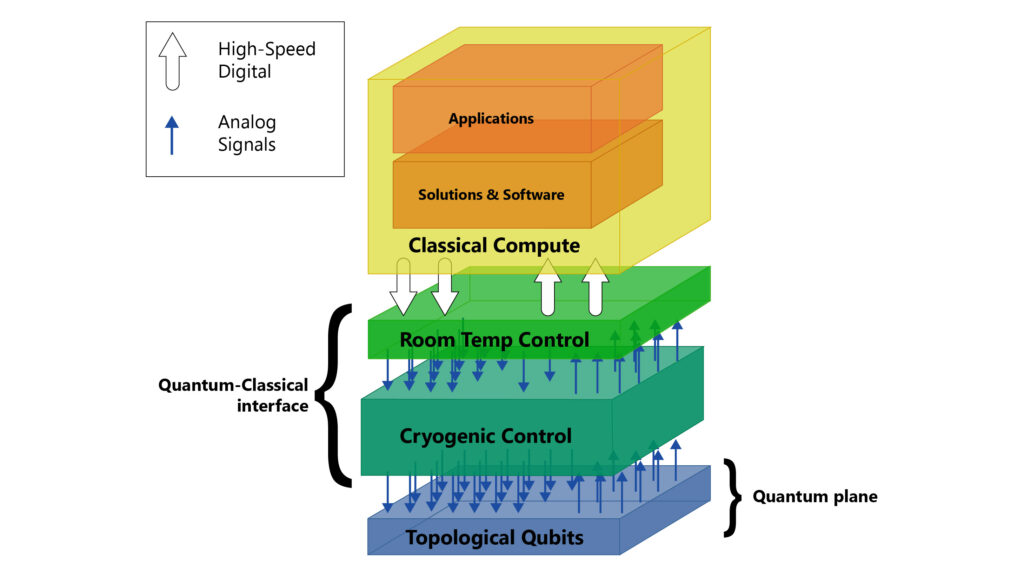
Although this is one of the unique features of Microsoft’s approach, it is not the only one. In the quantum stack, qubits make up its base. The quantum plane (at the bottom of Figure 1) is made up of a series of topological qubits (themselves made up of semiconductors, superconductors, and dielectrics), gates, wiring, and other packaging that help to process information from raw qubits. The vital processes of communication occur in the next layer higher in the stack (labeled “Quantum-Classical Interface” in Figure 1 above). The Gooseberry chip and cryo-compute core work together to bookend this communication. The latter sits at the bottom of the “Classical Compute” portion of the stack, and Gooseberry is unique relative to other control platforms in that it sits right down with the qubits at the same temperature as the quantum plane—able to convert classical instructions from the cryo-compute core into voltage signals sent to the qubits.
Play it cool: Dissipating heat in a CMOS-based control platform
Why does it matter where the Gooseberry chip sits? It is partly an issue of heat. When the wires that connect the control chip to the qubits are long (as they would have to be if the control chip were at room temperature), significant heat can be generated inside the fridge. Putting a control chip near the qubits avoids this problem. The tradeoff is that the chip is now near the qubits, and the heat generated by the chip could potentially warm up the qubits. Gooseberry navigates these competing effects by putting the control chip near, but not too near, the qubits. By putting Gooseberry in the refrigerator but thermally isolated from the qubits, heat created by the chip is drawn away from the qubits and into the mixing chamber. (See Figure 2 below).
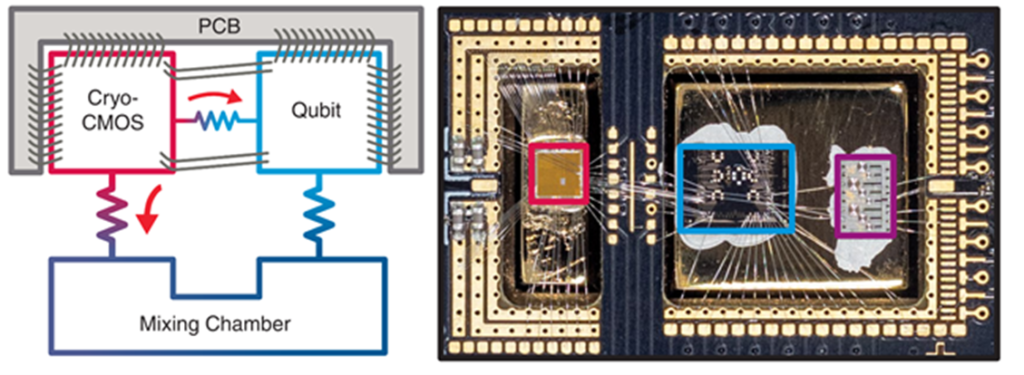
Placing the chip near the qubits at the quantum plane solves one set of problems with temperature but creates another. To operate a chip where the qubits are, it needs to function at the same temperature as the qubits—100 mK. Operating standard bulk CMOS chips at this temperature is challenging, so this chip uses fully-depleted silicon-on-insulator (FDSOI) technology, which optimizes the system for operation at cryogenic temperatures. It has a back-gate bias, with transistors having a fourth terminal that can be used to compensate for changes in temperature. This system of transistors and gates allows qubits to be calibrated individually, and the transistors send individualized voltages to each qubit.
Gates galore: No need for separate control lines from room temperature to every qubit
Another advantage of Gooseberry is that the chip is designed in such a way that the electrical gates controlling the qubits are charged from a single voltage source that cycles through the gates in a “round-robin” fashion, charging as necessary. Previous qubit controllers required one-to-one cables from multiple voltage sources at room temperature or 4K, compromising the ability to operate qubits at large scale. The design pioneered by Dr. Reilly’s team greatly reduces the heat dissipated by such a controller. The cryogenic temperatures also come into play here to make this possible—the extreme cold allows capacitors to hold their charge longer. This means that the gates need to be charged less frequently and produce less heat and other disruptions to qubit stability.
The Gooseberry chip is made up of both digital and analog blocks. Coupled digital logic circuits perform communication, waveform memory, and autonomous operation of the chip through a finite-state machine (FSM), and the digital part of the chip also includes a master oscillator (see Figure 3). The chip also uses a Serial Peripheral Interface (SPI) for easy communication higher up the quantum stack. The analog component of the chip is a series of cells, called “charge-lock fast-gate” (CLFG) cells, that perform two functions. First, the charge-lock function is the process for charging gates, as described above. The voltage stored on each gate is tailored to individual qubits. Information is processed in qubits by changing the voltages on the gate, and that happens in the second function, “fast-gating.” This creates pulses that physically manipulate the qubits, ultimately directing the processing of information in the qubits.
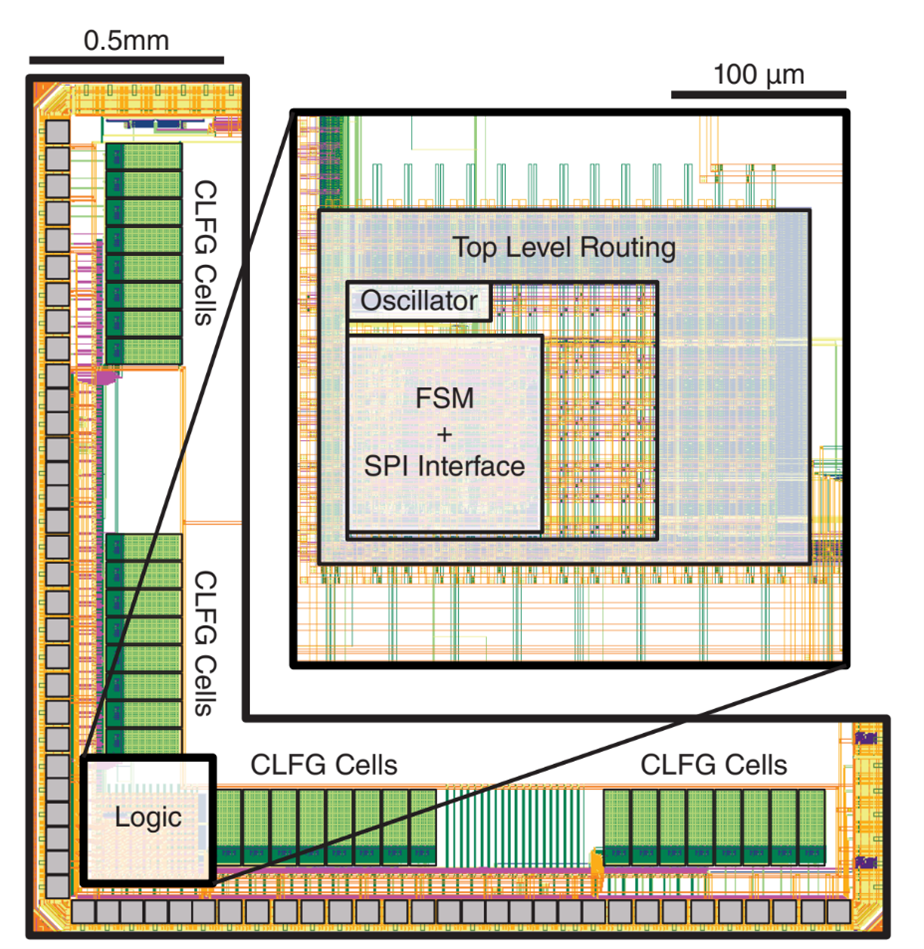
Benchmarking results of the cryo-CMOS control with a quantum dot chip
Low power dissipation is a key challenge when it comes to communicating with qubits efficiently via these pulses. There are three variables that impact power dissipation: voltage level, frequency, and capacitance. The voltage needed in this case is set by the qubit, and the frequency is set by both the qubit and clock rate of the quantum plane. This leaves capacitance as the only variable you can adjust to create low power dissipation when charging gates and sending pulses—low capacitance means low dissipation. The capacitors in this system are tiny, spaced close together, and are very near the quantum plane, so they require as little power as possible to shuffle charge between capacitors to communicate with the qubits.
The researchers tested the Gooseberry chip to see how it would perform by connecting it with a GaAs-based quantum dot (QD) device. Some of the gates in the quantum dot device were connected to a digital-analog converter (DAC) at room temperature to compare these results with standard control approaches. Power leakage from the CLFG cells is measured by a second quantum dot in the device, and measurements of the QD conductance provide a way to monitor the charge-locking process. The temperature of all the components of the chip are measured as the control chip is being powered up, revealing that temperature stays below 100 mK within the necessary range of frequencies or clock speeds (see figure 4). See the paper for more details on the benchmarking process.
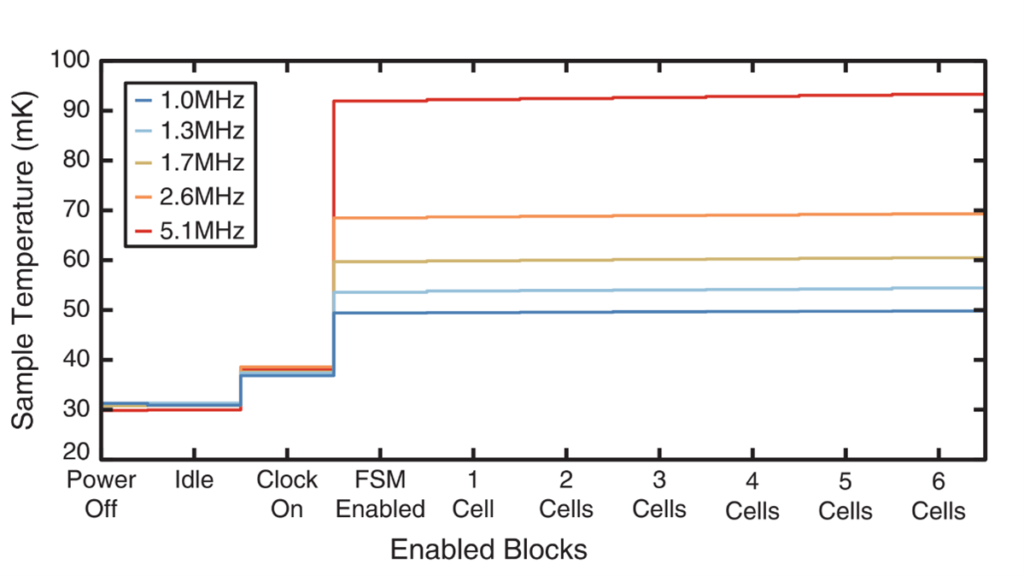
Extrapolating these results, the researchers estimated the total system power needed for the Gooseberry control chip as a function of frequency and the number of output gates. These results take into account both the clock speed and temperature needed for topological qubits, and Figure 5 shows that this chip is able to operate within the acceptable limits while communicating with thousands of qubits. This CMOS-based control approach also appears feasible for qubit platforms based on electron spins or gatemons.
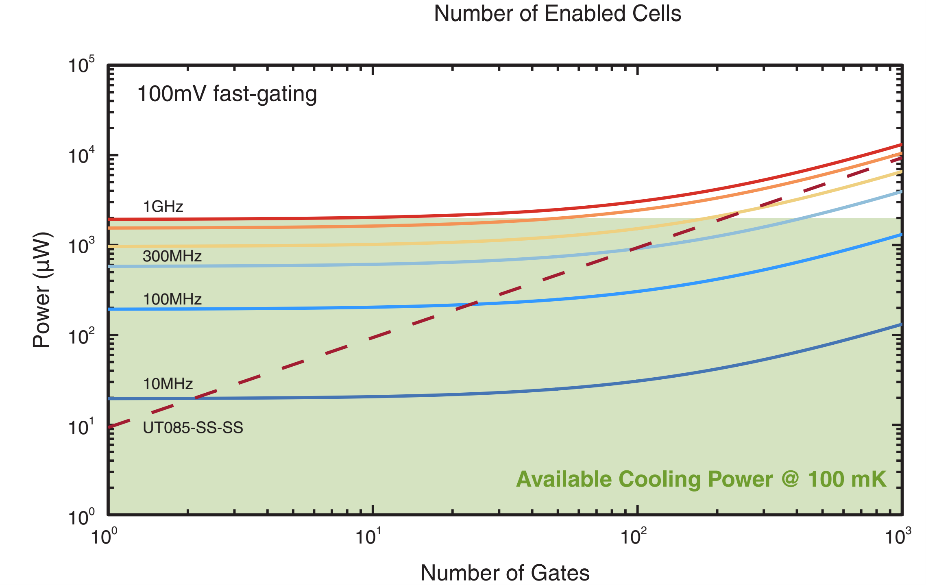
Proof of principle that general-purpose compute is possible at cryogenic temperatures
The general-purpose cryo-compute core is a recent development that continues the progress made by Gooseberry. This is a general-purpose CPU operating at cryogenic temperatures. At present, the core operates at approximately 2 K, and it handles some triggering manipulation and handling of data. With fewer limitations from temperature, it also deals with branching decision logic, which requires more digital circuit blocks and transistors than Gooseberry has. The core acts as an intermediary between Gooseberry and executable code that can be written by developers, allowing for software-configurable communication between the qubits and the outside world. This technology proves it’s possible to compile and run many different types of code (written on current tools) in a cryogenic environment, allowing for greater possibilities of what can be accomplished with qubits being controlled by the Gooseberry chip.
Journey before destination: The zen behind the Microsoft approach to quantum computers
There’s no doubt that both Gooseberry and the cryo-compute core represent big steps forward for quantum computing, and having these concepts peer-reviewed and validated by other scientists is another leap ahead. But there are still many more leaps needed by researchers before a meaningful quantum computer can be realized. This is one of the reasons Microsoft has chosen to focus on the long game. While it might be nice to ramp up one aspect of quantum computers—such as the number of qubits—there are many concepts to be developed beyond the fundamental building blocks of quantum computers, and researchers at Microsoft Quantum and the University of Sydney aren’t stopping with these results.
Projects like the Gooseberry chip and cryo-compute core take years to develop, but these researchers aren’t waiting to put new quantum projects into motion. The idea is to keep scaffolding prior work with new ideas so that all of the components necessary for quantum computing at large scale will be in place, enabling Microsoft to deliver solutions to many of the world’s most challenging problems.

